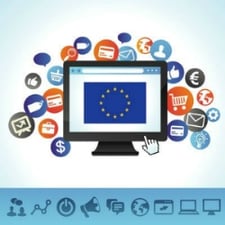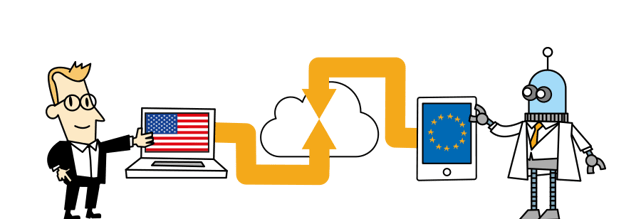Way back in May 2015, the European Commission (EC) presented its Digital Single Market (DSM) directive. Four months later and the program has advanced rapidly, with all concerned stakeholders now actively involved: not surprising given the economic and political import of the DSM! The European Parliament has held debates and issued statements; the European Council similarly, the EC has held numerous public consultations and published findings; European and non-European business interests (from digital infrastructure to service providers) are researching, employing lobbyists and taking position, while lawyers and accountants are readying themselves for streams of income. US interests are not on the side-lines, in fact market makers and leaders such as Google, Amazon, Facebook and Apple (GAFA) are the most visible piece of this DSM influencing relationship, which the US Mission to the EU considers one of its top three priorities.
The EC DSM established three main objectives:
1) Better access for consumers and businesses to digital goods and services across Europe
2) Creating the right conditions and a level playing field for digital networks and innovative services to flourish
3) Maximising growth potential of the digital economy
If you want to learn more, my colleague Tereza has done a great job detailing the directive, please see her blog.
Numerous organisations have held their DSM learning events across Europe, pulling together stakeholders and experts. The Trans-Atlantic Business Council (TABC) held its really useful “Perspectives on the EU’s Digital Single Market Strategy” in Brussels on September 15th. Tim Bennett (TABC Director General/CEO) flawlessly hosted a pedigree event kicking off with a Keynote Speech on the “DSM Strategy Content and Objectives”, by Juhan Lepassaar (Head of Cabinet, Vice-President Andurs Ansip, European Commission(EC)). We were informed that for the EC, the DSM was become an increasingly large and complex program, as they follow the required processes, while trying to keep to the fast track timetable and are heavily influenced by very active, conflicting EU and non-EU vested interests. The agenda for the afternoon was a check list of DSM essentials:
- Session 1 – Improving Access – e-Commerce, Copyrighting and Geo-Blocking. E-Commerce in Europe is the business game changer and so not surprisingly got everyone’s attention. The seemingly unstoppable double digit annual growth of e-commerce supports the recognition that we are just at the beginning of this transformative boom. We have blogged on EU e-commerce many times and will of course continue to do so. Geo-Blocking (geographically-blocked) was the other big testy subject in this session. Across the 28 member states of the EU today, there is widespread practice of preventing users (you and me) from accessing web sites, downloading media and applications, based on their geographic, country location. Netflix became the “cause celebre”, with the example of Netflix Belgium subscribers that were unable to view the same programming in say Spain or the UK. Geo-blocking is used by businesses and countries to restrict viewing and block certain material (example movie/TV studios). Technically this is easily done by internet address management systems. Down with geo-blocking!
- Session 2 – Creating the Right Environment: Telecoms, Media and Platforms. Led by Telefonica (#1 Spanish multinational by market cap, and one of the largest private telecommunications companies in the world), we were treated to a discussion on telecom operators (the US has just a hand-full, while we in Europe pay for over a hundred) and practices (all about speed and availability). Up with rationalisation and harmonisation!
- Session 3 – Maximising the Potential of the Digital Economy: Big Data, Cloud Data Protection, Emerging Technologies. No DSM discussion would be complete without the thorny issue of data and that means the management and protection of what is now big - and getting bigger every day - data. This, of course, all ties back to the U.S.-EU Safe Harbor (1998, data policy) agreement. Data has moved on (in many ways…) and inconsideration of the many recent and somewhat egregious data thefts (from Ashley Madison to the US National Security Agency). Expect lots of action here!

Perhaps the most interesting presentation came at the end of the afternoon, when Antony Gardner (U.S. Ambassador to the EU) gave us his The Transatlantic Perspective. It is a great read and I thank him for the quotes and information below. Click here to download. Looking at EU digital concerns and challenges from a US perspective, is extremely instructive if the EU is to get its DSM house in order by mid-2016. The Ambassador shared his view of the U.S./EU digital context: “As a starting point, it’s useful to keep in mind that cross-border data flows between the U.S. and Europe are the highest in the world - 50 percent higher than the data flows between the U.S. and Asia in absolute terms, and 400 percent higher on a per capita basis”. He asked us to recall (it was new to me) “that in addition to being each other’s largest trading partners for digitally deliverable services, the U.S. and the EU are also the two largest net exporters of these services to the world, which represent approximately 75 percent of all products traded and delivered online. The EU, not the U.S., is the world’s largest net exporter of digitally deliverable services. And demonstrating the interconnectedness of U.S. and European industries, 53 percent of digitally deliverable services imported from the U.S. (including consulting, engineering, design, and financial services) were used in the production of EU exports, and 62 percent of digitally deliverable services imported from the EU were incorporated into U.S. exports”.
US tech platforms in Europe, have been hugely successful, the benefits of which, also accrue to European businesses. Created in 2008, yes just 7 years ago, Apple’s App Store, in 2013 provided European app developers with >€17.5Bn income. This figure is expected to reach >€63Bn in 2018 and employ just short of 3 million Europeans. Those concerned by European economic integration can take heart, and example, from Amazon’s 28 European country-specific digital platforms. In 2014, European SMEs using Amazon earned >€2.8Bn in intra-European export revenue. Facebook, added to the good news in 2014, generating €44Bn in Europe and enabling 783,000 jobs. GAFA in Europe delivers.
Looking to the future, the Ambassador quoted Carl Bildt (perennial Swedish politician and diplomat who was Prime Minister of Sweden from 1991-94) “The right way to bolster European business is not to legislate to disadvantage their rivals. It is to encourage the culture of innovation and entrepreneurship that has produced the US companies that many now fear...Digital mercantilism – a misguided attempt to regulate away competition, or build up new boundaries to achieve some imaginary sovereignty in cyberspace – can only hurt Europe’s ability to innovate, compete and succeed in this new world.” If this message was not clear enough, the Ambassador declared that he was seeking “Partners, not rivals. The United States Government and U.S. technology companies look forward to being partners, not adversaries, as Europe’s governments and companies work to make the DSM a reality”. It sounds good and makes clear that the US/EU transatlantic digital relationship will continue to shape the EU DSM.

